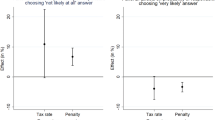Abstract
In a survey of Australian citizens (valid N = 1,406), personal and social norms were found to moderate effects of deterrence on tax evasion. Personal, internalized norms of tax honesty were negatively related to tax evasion and moderated the effects of deterrence variables (i.e., sanction severity), suggesting deterrence effects only when individual ethics were weak. Perceived social norms, beyond those internalized as personal norms, were not directly related to tax evasion but moderated the effects of sanction severity. Only when social norms were seen as strongly in favor of tax honesty was sanction severity negatively related to tax evasion. This result held only for respondents who did not identify strongly as Australians. Hence, when internalized, norms delimit effects of deterrence; when considered external to one's self, norms boost deterrence effects, giving social meaning to formal sanctions.
Similar content being viewed by others
REFERENCES
Aiken, L. S., & West, S. G. (1991). Multiple regression: Testing and interpreting interactions. Newbury Park, CA: Sage.
Allingham, M. G., & Sandmo, A. (1972). Income tax evasion: A theoretical analysis. Journal of Public Economics, 1, 323–338.
Alm, J., McClelland, G. H., & Schulze, W. D. (1992). Why do people pay taxes? Journal of Public Economics, 48,21–38.
Alm, J., McClelland, G. H., & Schulze, W. D. (1999). Changing the social norm of tax compliance by voting. Kyklos, 52, 141–171.
Alm, J., Sanchez, I., & DeJuan, A. (1995). Economic and noneconomic factors in tax compliance. Kyklos, 48,3–18.
Andenaes, J. (1974). Punishment and deterrence. Ann Arbor: University of Michigan Press.
Andreoni, J., Erard, B., & Feinstein, J. (1998). Tax compliance. Journal of Economic Literature, 36(2), 818–860.
Bachman, R., Paternoster, R., & Ward, S. (1992). The rationality of sexual offending: Testing a deterrence/ rational choice conception of sexual assault. Law and Society Review, 26, 343–372.
Bosco, L., & Mittone, L. (1997). Tax evasion and moral constraints: Some experimental evidence. Kyklos, 50, 297–324.
Braithwaite, J. (1989). Crime, shame, and reintegration. Cambridge: Cambridge University Press.
Braithwaite, J. (2002). Restorative justice and responsive regulation. New York: Oxford University Press.
Braithwaite, V. (2000). The community hopes, fears and actions survey. Canberra: Centre for Tax System Integrity, Research School of Social Sciences, Australian National University.
Burkett, S. R., & Ward, D. A. (1993). A note on perceptual deterrence, religiously based moral condemnation, and social-control. Criminology, 31, 119–134.
Carroll, J. S. (1978). A psychological approach to deterrence: The evaluation of crime opportunities. Journal of Personality and Social Psychology, 36, 1512–1520.
Carroll, J. S. (1987). Compliance with the law: Adecison-making approach to taxpaying. Law and Human Behavior, 11, 319–335.
Cowell, F. A. (1992). Tax evasion and inequity. Journal of Economic Psychology, 13(4), 521–543.
DeJuan, A., Lasheras, M. A., & Mayo, R. (1994). Voluntary tax compliant behavior of Spanish income tax payers. Public Finance, 49,90–105.
Dubin, J. A., Graetz, M. J., & Wilde, L. L. (1987). Are we a nation of tax cheaters? New econometric evidence on tax compliance. The American Economic Review, 77, 240–245.
Dubin, J. A., & Wilde, L. L. (1988). An empirical analysis of federal income tax auditing and compliance. National Tax Journal, 16,61–74.
Elffers, H., Weigel, R. H., & Hessing, D. J. (1987). The consequences of different strategies for measuring tax evasion behavior. Journal of Economic Psychology, 8, 311–337.
Erard, B., & Feinstein, J. S. (1994). The role of moral sentiments and audit perceptions in tax compliance. Public Finance, 49,70–89.
Falkinger, J. (1995). Tax evasion, consumption of public goods and fairness. Journal of Economic Psychology, 16,63–72.
Fischer, C. M., Wartick, M., & Mark, M. M. (1992). Detection probability and taxpayer compliance: A review of the literature. Journal of Accounting Literature, 11,1–46.
Franzoni, L. A. (2000). Tax evasion and tax compliance. In B. Bouckaert & G. DeGeest (Eds.), Encyclopedia of law and economics (Vol. 4, pp. 52–94). Cheltenham, UK: Elgar.
Friedland, N., Maital, S., & Rutenberg, A. (1978). A simulation study of income tax evasion. Journal of Public Economics, 10, 107–116.
Gibbs, J. P. (1975). Crime, punishment, and deterrence. New York: Elsevier.
Grasmick, H. G., & Bursik R. J., Jr. (1990). Conscience, significant others, and rational choice: Extending the deterrence model. Law and Society Review, 24(3), 837–861.
Grasmick, H. G., & Green, D. E. (1980). Legal punishment, social disapproval and internalization as inhibitors of illegal behavior. Journal of Criminal Law and Criminology, 71, 325–335.
Grasmick, H. G., & Scott, W. J. (1982). Tax evasion and mechanisms of social control: A comparison with grand and petty theft. Journal of Economic Psychology, 2, 213–230.
Harcourt, B. E. (2000). After the "social meaning turn": Implications for research design and methods of proof in contemporary criminal law policy analysis. Law and Society Review, 34, 179–211.
Haslam, S. A. (2001). Psychology in organizations: The social identity approach. London: Sage.
Hasseldine, J., & Kaplan, S. E. (1992). The effect of different sanction communications on hypothetical taxpayer compliance: Policy implications from New Zealand. Public Finance, 47,45–60.
Hessing, D. J., Elffers, H., Robben, H. S. J., & Webley, P. (1992). Does deterrence deter? Measuring the effect of deterrence on tax compliance in field studies and experimental studies. In J. Slemrod (Ed.), Why people pay taxes: Tax compliance and enforcement (pp. 291–305). Ann Arbor: University of Michigan Press.
Howe, E. S., & Brandau, C. J. (1988). Additive effects of certainty, severity, and celerity of punishment on judgments of crime deterrence scale value. Journal of Applied Social Psychology, 18, 796–812.
Howe, E. S., & Loftus, T. C. (1996). Integration of certainty, severity, and celerity information in judged deterrence value: Further evidence and methodological equivalence. Journal of Applied Social Psychology, 26, 226–242.
Kahan, D. M. (1996). What do alternative sanctions mean? University of Chicago Law Review, 63, 591–653.
Kaplan, S. E., & Reckers, P. M. J. (1985). A study of tax evasion judgments. National Tax Journal, 38, 97–102.
Kelman, H. C. (1958). Compliance, identification, and internalization: Three processes of attitude change. Journal of Conflict Resolution, 2,51–60.
Kinsey, K. A., & Grasmick, H. G. (1993). Did the tax reform act of 1986 improve compliance? Three studies of pre-and post-TRA compliance attitudes. Law and Policy, 15, 239–325.
Mason, R., & Calvin, L. D. (1978). A study of admitted income tax evasion. Law and Society, 13,73–89.
McAdams, R. H. (1997). The origin, development, and regulation of norms. Michigan Law Review, 96, 338–433.
Mearns, M., & Braithwaite, V. (2001). The community hopes, fears and action survey: Survey method, sample representativeness and data quality. Centre for Tax System Integrity Working Paper No. 4, Australian National University, Canberra.
Nagin, D. S., & Paternoster, R. (1991). The preventive effects of the perceived risk of arrest: Testing an expanded conception of deterrence. Criminology, 29, 561-587.
Nagin, D. S., & Paternoster, R. (1993). Enduring individual differences and rational choice theories of crime. Law and Society Review, 27, 467–496.
Pate, A. M., & Hamilton, E. E. (1992). Formal and informal deterrents to domestic violence: The Dade county spouse assault experiment. American Sociological Review, 57, 691–697.
Paternoster, R. (1987). The deterrent effect of the perceived certainty and severity of punishment: A review of the evidence and issues. Justice Quarterly, 4, 173–217.
Paternoster, R., Saltzman, L. E., Waldo, G. P., & Chiricos, T. G. (1983). Perceived risk and social control: Do sanctions really deter? Law and Society Review, 17, 457–479.
Paternoster, R., & Simpson, S. S. (1996). Sanction threats and appeals to morality: Testing a rational choice model of corporate crime. Law and Society Review, 30, 549–583.
Reckers, P. M. J., Sanders, D. L., & Roark, S. J. (1994). The influence of ethical attitudes on taxpayer compliance. National Tax Journal, 47, 825–836.
Schmölders, G. (1970). Survey research in public finance: A behavioural approach to fiscal theory. Public Finance, 25, 300–306.
Schwartz, R. D., & Orleans, S. (1967). On legal sanctions. University of Chicago Law Review, 34, 274–300.
Scott, W. J., & Grasmick, H. G. (1981). Deterrence and income tax cheating: Testing interaction hypotheses in utilitarian theories. Journal of Applied Behavioural Science, 17, 395–408.
Sheffrin, S. M., & Triest, R. K. (1992). Can brute deterrence backfire? Perceptions and attitudes in taxpayer compliance. In J. Slemrod (Ed.), Who pays taxes and why? Tax compliance and enforcement (pp. 193–218). Ann Arbor: University of Michigan Press.
Sherman, L. W., Smith, D. A., Schmidt, J. D., & Rogan, D. P. (1992). Crime, punishment, and stake in conformity: Legal and informal control of domestic violence. American Sociological Review, 57, 680–690.
Simpson, S. S. (2002). Corporate crime, law, and social control. Cambridge, UK: Cambridge University Press.
Smith, K. W. (1990). Integrating three perspectives on noncompliance: A sequential decision model. Criminal Justice and Behavior, 17, 350–369.
Stafford, M. C., Gray, L. N., Menke, B. A., & Ward, D. A. (1986). Modeling the deterrent effects of punishment. Social Psychology Quarterly, 49, 338–347.
Tittle, C. R., & Logan, C. H. (1973). Sanctions and deviance: Evidence and remaining questions. Law and Society Review, 7, 371–392.
Turner, J. C. (1991). Social influence. Buckingham, UK: Open University Press.
Varma, K. N., & Doob, A. N. (1998). Deterring economic crimes: The case of tax evasion. Canadian Journal of Criminology, 40, 165–184.
Vogel, J. (1974). Taxation and public opinion in Sweden: An interpretation of recent survey data. National Tax Journal, 27, 499–513.
Wallschutzky, I. G. (1984). Possible causes of tax evasion. Journal of Economic Psychology, 5, 371–384.
Wallschutzky, I. G. (1996). Issues in research methods: With reference to income tax research. Unpublished manuscript, University of Newcastle, Australia.
Webley, P. (1987). Audit probabilities and tax evasion in a business simulation. Economics Letters, 25, 267–270.
Webley, P., & Halstead, S. (1986). Tax evasion on the micro: Significant simulations or expedient experiments? The Journal of Interdisciplinary Economics, 1,87–100.
Wenzel, M. (2002). The impact of outcome orientation and justice concerns on tax compliance: The role of taxpayers' identity. Journal of Applied Psychology, 87, 629–645.
Wenzel, M. (2004). An analysis of norm processes in tax compliance. Journal of Economic Psychology, 25, 213–228.
Williams, K. R., & Hawkins, R. (1986). Perceptual research on general deterrence: A critical review. Law and Society Review, 20, 545–572.
Witte, A. D., & Woodbury, D. F. (1985). The effect of tax laws and tax administration on tax compliance: The case of the U.S. individual income tax. National Tax Journal, 38,1–13.
Zimring, F. E., & Hawkins, G. J. (1971). The legal threat as an instrument of social change. Journal of Social Issues, 27,33–48.
Author information
Authors and Affiliations
About this article
Cite this article
Wenzel, M. The Social Side of Sanctions: Personal and Social Norms as Moderators of Deterrence. Law Hum Behav 28, 547–567 (2004). https://doi.org/10.1023/B:LAHU.0000046433.57588.71
Issue Date:
DOI: https://doi.org/10.1023/B:LAHU.0000046433.57588.71




